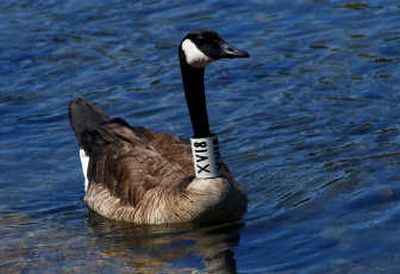As geese get cozy, study aims to uncover habits

Spokane is near enough to nature for growing numbers of Canada geese.
Instead of taking to the skies each autumn and spring in their telltale V-shaped migration formations, large flocks of geese seem to have taken up full-time residence in Spokane and Coeur d’Alene.
“They have plenty of water for safety, plenty of grass for food and not too much exposure to predators,” said Mikal Moore, a waterfowl biologist with the Washington Department of Fish and Wildlife. “The geese aren’t limited to anything that they would be in nature.”
The contentment of geese has become an annoyance to people, especially at beaches, grassy playing fields and golf courses. Prompted by increasing complaints about the goose droppings covering these spots, the Washington Department of Fish and Wildlife has launched a study of Spokane’s urban geese population.
Earlier this summer, the agency trapped and placed white plastic collars on 28 adult geese in two areas that seem especially popular with the birds: Gonzaga University’s soccer fields and The Creek at Qualchan golf course. An additional 61 juvenile geese were leg-banded in these areas.
The banding took place when the adult geese don’t have flight feathers, which allowed workers to herd the geese into pens without injuring them, said Moore, who is leading the study.
Over the next year, with help from citizen observers, the agency hopes to get an idea of where these geese live. The information is the first step in developing an urban goose management plan, Moore said.
“We don’t know anything about their movement patterns: whether they stay in Spokane all winter, whether they migrate, whether they’re exposed to hunting,” Moore said.
When the agency conducted a similar study of urban geese in Clarkston, scientists discovered some of the resident geese do, in fact, migrate.
“Clarkston geese moved between Clarkston and Spokane,” Moore said. “They went from one urban environment to another, but they never spent any time in traditional goose areas.”
Upward of 50 geese at a time can be spotted on Gonzaga’s soccer fields, said Dale Goodwin, a spokesman for the university. The mess has become a safety and health problem for athletes.
“They’ve got goose poop all over their shoes and knees. They slide on it,” Goodwin said, adding the university has few options to keep the geese off the grass. “About all we can do is chase them off.”
North Idaho College in Coeur d’Alene banned the feeding of geese last year along most of its beach area. People continue to feed the waterfowl, and portions of the beach remain slathered in droppings, said college spokesman Kent Probst.
Although the region’s geese might no longer join their cousins on long migrations each spring and fall, the birds remain protected under federal law, said Tom Buckley, with the U.S. Fish and Wildlife Service office in Spokane. Killing the geese or removing their eggs is illegal without a federal permit.
Other communities, golf courses and airports have obtained permits to control their resident geese flocks, Buckley said. The methods of control include using trained dogs to chase the geese, expanding hunting seasons, gassing the birds or slathering newly laid eggs with corn oil to prevent embryonic development.
But Buckley also said geese shouldn’t necessarily be blamed for setting up housekeeping on the grass that covers ever-growing swaths of waterfront.
“When humans create these beautiful lawns and put them near a water source, it creates a natural attractant and habitat for the geese. It’s that old adage: If you build it they will come,” Buckley said. “People should be aware that when they construct these things, that’s always a potential. We live in an area where there’s a flyway.”